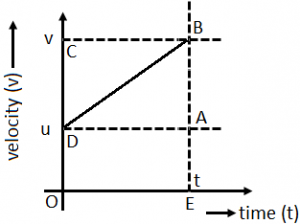First Equation of Motion by Graphical Method
Consider an object is moving with a uniform acceleration “a” along a straight line. The initial and final velocities of the object at time t = 0 and t = t are u and v respectively. During time t, let s be the total distance travelled by the object. In uniformly acceleration motion the velocity – time graph of an object is a straight line, inclined to the time axis.

OD = u; OC = v and OE = DA = t.
Let, the Initial velocity of the object = u
Let, the object is moving with uniform acceleration, a
Let, the object reaches at point B after time t, and its final velocity becomes, v.
Draw a line parallel to x-axis DA from point, D from where object starts moving.
Draw another line BA from point B parallel to Y-axis which meets at E at y-axis.
First Equation of Motion:
Let, OE = time (t)
From the graph:
BE = AB + AE
V = DC + OD (QAB = DC & AE = OD)
V = DC + v [QOD = u]
V = DC + V … (1)
Now, Acceleration (a) = Change in Velocity/ Time taken.
a = (v – u)/ t
a = (OC – OD)/ t = DC/ t
at = DC … (2)
By substituting the value of DC from (2) in (1):
We get:
V = at + u
V = u + at
It is the relation among initial velocity (u), final velocity (v), acceleration (a) and time (t).
It is called first equation of motion.
